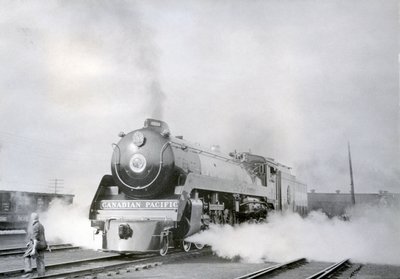Canadian Pacific Royal Hudson 2850
Description
- Mystery Question
- Sources suggest this photo of CP Royal Hudson 2850 may have been taken in Brighton during the royal visit in 1939. Does anyone have a similar photo? What are the buildings in the background?[Please answer by clicking on the Comments tab]
- Media Type
- Image
- Text
- Item Type
- Photographs
- Description
- The First Royal Hudson: 2850
Article reproduced from CPR News, Steel Wheel column by Jonathan Hanna, Corporate Historian.
The most famous of the CPR steam locomotives are the Royal Hudsons. And the most famous CPR Royal Hudson is 2850.
Across North America, locomotives with the 4-6-4 wheel arrangement are known as Hudson-type locomotives. New York Central Railroad (NYC) popularized them, running along New York State's Hudson River. There have been 487 Hudson locomotives operating in North America over the years; NYC had the lion's share at 195.
CPR had the second largest stable of Hudsons, with 65. CPR acquired 45 of the semi-streamlined versions between 1937 and 1940. These 45 locomotives joined 20 non-streamlined Hudsons acquired in 1929 and 1930.
The locomotives were used mostly in heavy passenger service because of their ability to reach high speeds pulling full-sized passenger trains.
They were also used in fast freight service. One of the secrets of their success was boosters, geared steam engines, attached to their trailing trucks, added to many of the locomotives in their class.
Two non-streamlined Hudsons (2811 ft 2813) and 15 semi-streamlined Royal Hudsons (2838-42, 2850-54, 2860-64) were built with boosters to increase tractive effort and help propel heavier trains from a standing start.
In 1939, Their Majesties King George VI and Queen Elizabeth visited Canada and the US. Two CPR Hudson locomotives were selected to pull the Royal Train and Pilot Train - which preceded the Royal Train, carrying support staff and press people - over CPR's rail system: 2850 and 2851. The former was assigned to pull the Royal Train, and the latter the Pilot Train. Locomotive 2850 was decked out in royal blue, dark blue and aluminum livery, with royal crowns and warrants, and placed at the head of its matching coaches. The CPR portion of the royal couple's North American tour set the company record for a single, continuous steam locomotive run, with 2850 and 2851 travelling 5,000 km (3,100 miles) in May of 1939.
Neither locomotive experienced any mechanical trouble during the marathon run. And other than on a couple of steep mountain sections, each locomotive pulled its train solo. Other Royal Hudsons also distinguished themselves in continuous service. Locomotives 2838, 2839, 2840 and 2841 - on the Toronto-Fort William (Thunder Bay) run - averaged more than 644 km (400 miles) a day for 10 continuous months. No. 2858 averaged 859 km (534 miles) per day during nine months of continuous service.
And 2859 eclipsed them all with 959 km (596 miles) per day during an eight-month stint in continuous service.
Still in its blue-and-silver Royal Train livery, 2850 went to the New York World's Fair, in the summer of 1939, to represent CPR in the Railroads on Parade pageant. Afterwards it returned to its original tuscan-and-grey livery, but kept its royal crowns on the running board valences. CPR received royal assent to keep these crowns on both 2850 and 2851. The honor was soon extended to apply royal crowns to all 45 semi-streamlined Hudson-type locomotives, thus the designation Royal Hudsons.
Four CPR Royal Hudsons are still in existence. The original - 2850 - is preserved in the Canadian Railway Museum in St. Constant, Que. No. 2839 is being cosmetically restored and is on display in Sylmar, California.
No. 2858 is in Ottawa, on display in the Canada Science & Technology Museum. And 2860, when operating, takes tourists from North Vancouver to Squamish, B.C.
and
From Significant dates in Canadian railway history. Colin Churcher's Railway Pages. 2006-03-17. Retrieved 2006-05-17.
In 1939, King George VI and Queen Elizabeth visited Canada, arriving at Wolfe's Cove, Quebec, on 17 May 1939. This was the first time that a reigning monarch had visited Canada. The King and Queen took a tour of the country by rail. The CPR and the Canadian National Railways (CNR) shared the honours of transporting the royal train across the country, with the CPR undertaking the westbound journey, from Quebec City to Vancouver. The steam locomotive that the CPR used to pull the train was numbered 2850, a 4-6-4 built by Montreal Locomotive works. Specially painted in silver and blue, the locomotive ran 3,224 mi (5,189 km) across Canada, through 25 changes of crew, without engine failure. The King, somewhat of a rail buff, rode in the cab when possible. The King was very impressed with the performance of 2850 and her class, that after the tour, the King gave the CPR permission to use the term Royal Hudson for the semi-streamlined locomotives of the class (numbered 2820-2859, 2860-2864 were built one year later as Royal Hudsons) and to display Royal Crowns on the running boards. This was the first, and last time a locomotive outside of the United Kingdom was given royal status by the reigning monarch.
- Subject(s)
- Personal Name(s)
- His Majesty King George VI ; Her Majesty Queen Elizabeth
- Corporate Name(s)
- Canadian Pacific Royal Hudson 2850
- Local identifier
- abdap_king-002
- Language of Item
- English
- Donor
- Geneva Kinney
- Copyright Statement
- Copyright status unknown. Responsibility for determining the copyright status and any use rests exclusively with the user.
- Contact
- Brighton Digital ArchivesEmail:brightondigitalarchives@gmail.com
Agency street/mail address:Brighton Public Library
35 Alice Street
P.O. Box 129
Brighton, ON K0K 1H0

